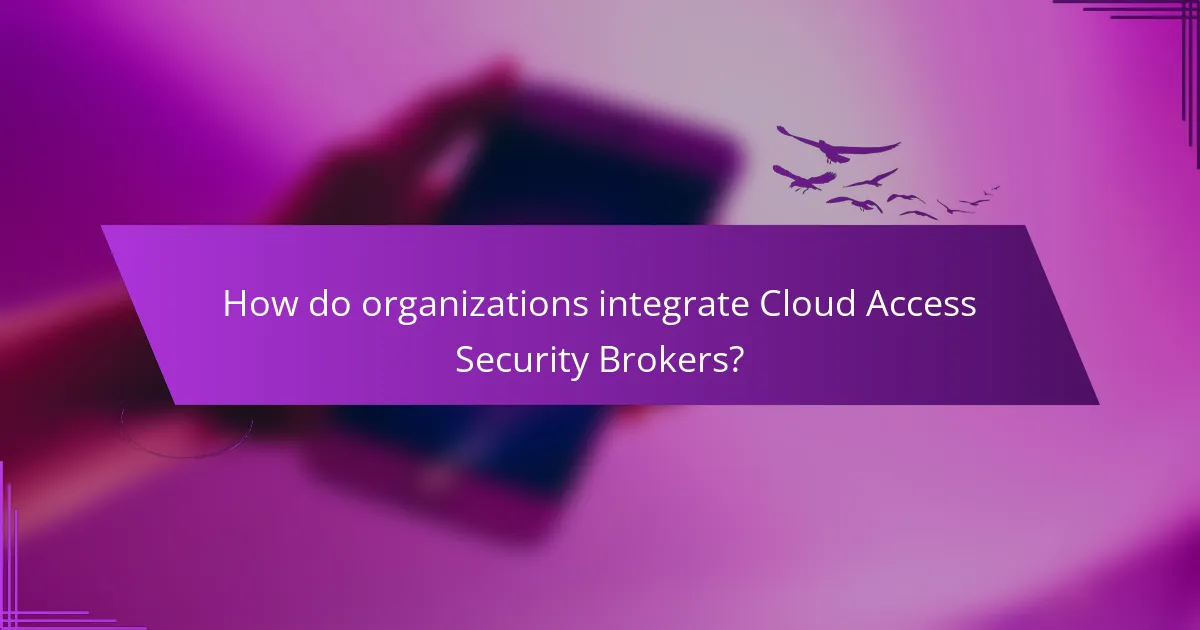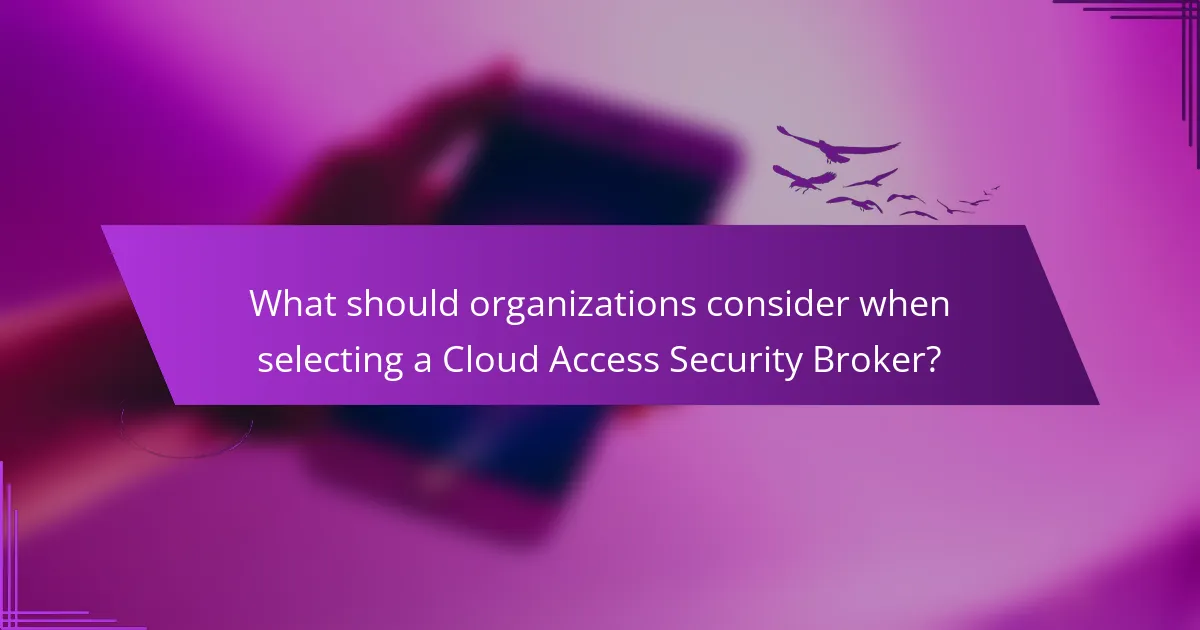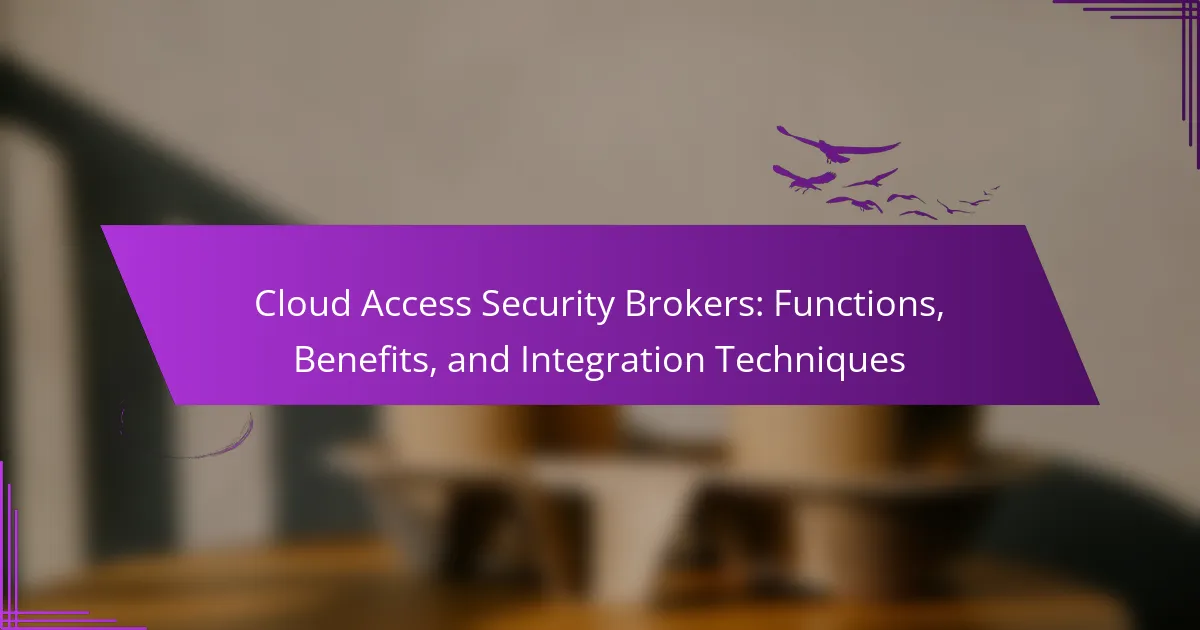
What are Cloud Access Security Brokers?
Cloud Access Security Brokers (CASBs) are security solutions that act as intermediaries between cloud service users and cloud service providers. They provide visibility, compliance, data security, and threat protection for cloud services. CASBs enforce security policies for cloud applications. They help organizations manage risks associated with cloud computing. CASBs can monitor user activities and data transfers in real-time. They often integrate with existing security frameworks to enhance overall protection. According to a report by Gartner, CASBs are essential for securing sensitive data in the cloud. This highlights their growing importance in modern IT security strategies.
How do Cloud Access Security Brokers function?
Cloud Access Security Brokers (CASBs) function as intermediaries between cloud service users and cloud applications. They enforce security policies and compliance measures for data in transit to and from cloud services. CASBs provide visibility into cloud usage and data security risks. They monitor user activity and detect anomalies. CASBs also help in data loss prevention by identifying sensitive information. They can encrypt data before it is sent to the cloud. Integration with existing security tools enhances overall security posture. According to Gartner, CASBs can reduce the risk of data breaches by up to 60%.
What are the key components of Cloud Access Security Brokers?
The key components of Cloud Access Security Brokers (CASBs) include visibility, compliance, data security, and threat protection. Visibility allows organizations to monitor and manage cloud service usage effectively. Compliance ensures that cloud usage adheres to regulations and policies. Data security protects sensitive information through encryption and access controls. Threat protection identifies and mitigates risks associated with malicious activities. These components work together to enhance security in cloud environments.
How do these components interact to enhance security?
Cloud Access Security Brokers (CASBs) enhance security by integrating multiple components such as data encryption, access controls, and threat detection. These components work together to provide a comprehensive security framework. Data encryption protects sensitive information during transmission and storage. Access controls ensure that only authorized users can access specific data and applications. Threat detection continuously monitors for unusual activities and potential security breaches. By combining these components, CASBs create a multi-layered defense strategy. This strategy helps organizations mitigate risks associated with cloud services. According to a report from Gartner, organizations using CASBs can reduce unauthorized access incidents by up to 30%.
What are the primary functions of Cloud Access Security Brokers?
Cloud Access Security Brokers (CASBs) primarily function as intermediaries between cloud service users and cloud service providers. They enforce security policies and ensure compliance with regulations. CASBs provide visibility into cloud application usage. They help identify and mitigate risks associated with data breaches. CASBs also enable data encryption and tokenization for sensitive information. They facilitate secure access to cloud services through authentication and authorization measures. Additionally, CASBs monitor user activity for anomalous behavior. According to a report by Gartner, 70% of organizations using CASBs reported improved data security in cloud environments.
How do Cloud Access Security Brokers facilitate data security?
Cloud Access Security Brokers (CASBs) facilitate data security by acting as intermediaries between cloud service users and providers. They enforce security policies across cloud applications. CASBs provide visibility into cloud usage and data flows. They help organizations monitor user activity and data access. CASBs enable data encryption both in transit and at rest. They also implement access controls based on user roles and contexts. Furthermore, CASBs can detect and respond to anomalies and threats in real-time. By integrating with existing security tools, CASBs enhance overall security posture.
What role do they play in compliance management?
Cloud Access Security Brokers (CASBs) play a critical role in compliance management. They provide visibility into cloud service usage and enforce security policies. CASBs help organizations meet regulatory requirements by monitoring data access and usage. They also assist in data loss prevention through encryption and tokenization. By integrating with existing security tools, CASBs enhance overall compliance efforts. Their capabilities enable organizations to identify and mitigate compliance risks effectively. This ensures adherence to standards such as GDPR and HIPAA. CASBs act as intermediaries between users and cloud services, ensuring secure data interactions.
What benefits do Cloud Access Security Brokers provide?
Cloud Access Security Brokers (CASBs) provide enhanced security for cloud services. They act as intermediaries between users and cloud service providers. CASBs enforce security policies and ensure compliance with regulations. They offer visibility into cloud usage, helping organizations monitor data access and transfer. CASBs protect sensitive data through encryption and tokenization. They also provide threat protection by detecting and responding to malicious activities. According to a 2021 report by Gartner, 70% of organizations using CASBs reported improved security posture. This demonstrates the effectiveness of CASBs in safeguarding cloud environments.
How do they improve visibility into cloud applications?
Cloud Access Security Brokers (CASBs) improve visibility into cloud applications by providing centralized monitoring and management of cloud services. They offer real-time visibility into user activities and data flows across various cloud platforms. CASBs use advanced analytics to detect anomalies and assess risks associated with cloud usage. They enable organizations to create policies that govern cloud application access and usage. This helps in identifying unauthorized access and potential security threats. Moreover, CASBs provide detailed reporting and auditing capabilities, which enhance compliance with regulations. By integrating with existing security tools, CASBs further enhance visibility and control over cloud environments.
What cost savings can organizations expect from using them?
Organizations can expect significant cost savings from using Cloud Access Security Brokers (CASBs). These savings often stem from reduced security incidents and breaches. According to a study by McKinsey, organizations can save up to 30% in security costs through effective cloud security solutions. CASBs streamline compliance processes, which can lower operational expenses. By automating security controls, organizations can decrease the need for extensive manual oversight. Furthermore, CASBs enhance visibility into cloud usage, allowing organizations to optimize resources and reduce waste. This leads to better budget allocation and overall cost efficiency.

How do organizations integrate Cloud Access Security Brokers?
Organizations integrate Cloud Access Security Brokers (CASBs) by following a structured approach. First, they assess their cloud service usage and security requirements. This helps identify the specific needs for data protection and compliance. Next, organizations select a CASB that aligns with their security policies and cloud environments. They then deploy the CASB, often integrating it with existing security tools like firewalls and identity management systems.
Configuration follows, where policies are defined for data access, encryption, and threat detection. Organizations also conduct testing to ensure the CASB functions as intended across various cloud applications. Finally, continuous monitoring and updates are necessary to adapt to evolving threats and compliance regulations. This integration process enhances visibility and control over cloud services, ultimately improving security posture.
What are the common integration techniques for Cloud Access Security Brokers?
Common integration techniques for Cloud Access Security Brokers (CASBs) include API integration, proxy-based integration, and inline integration. API integration allows CASBs to communicate directly with cloud services to enforce security policies. Proxy-based integration routes traffic through the CASB, enabling visibility and control over data in transit. Inline integration involves deploying the CASB within the network to monitor and secure data flows. These techniques enhance security by ensuring compliance, data protection, and threat detection across cloud applications.
How can organizations leverage APIs for integration?
Organizations can leverage APIs for integration by facilitating seamless communication between different software systems. APIs enable data exchange, allowing applications to interact without human intervention. This integration enhances operational efficiency and reduces manual errors. For instance, organizations can automate workflows by connecting customer relationship management (CRM) systems with marketing platforms. According to a report by MuleSoft, 83% of IT leaders believe APIs are critical for achieving digital transformation. This demonstrates the importance of APIs in streamlining processes and improving data accessibility across platforms.
What are the best practices for integrating with existing security frameworks?
The best practices for integrating with existing security frameworks include assessing current security policies and controls. Organizations should identify gaps between their existing frameworks and the new integration. Next, they must ensure compatibility of technologies and protocols used. This involves aligning security measures with industry standards such as NIST or ISO. Regular communication with stakeholders is essential for understanding requirements and expectations. Additionally, continuous monitoring and updating of security measures are necessary to respond to evolving threats. Training staff on the integrated framework enhances compliance and effectiveness. Finally, documenting all integration processes aids in maintaining transparency and accountability.
What challenges may arise during the integration of Cloud Access Security Brokers?
Integration of Cloud Access Security Brokers (CASBs) may face several challenges. Compatibility issues can arise with existing IT infrastructure. Organizations may struggle with integrating CASBs into diverse cloud environments. Data privacy concerns can complicate compliance with regulations. User training is often necessary to ensure effective use of CASBs. Performance impacts may occur if CASBs are not optimized. Additionally, managing multiple cloud services can lead to complexity. These factors can hinder the seamless deployment of CASBs in an organization.
How can organizations address compatibility issues?
Organizations can address compatibility issues by implementing standardized protocols and integration frameworks. These frameworks facilitate seamless communication between different systems. Regular software updates help maintain compatibility with evolving technologies. Conducting compatibility assessments before integration can identify potential issues early. Training staff on new systems ensures effective usage and minimizes errors. Utilizing middleware solutions can bridge gaps between incompatible systems. Testing integrations in a controlled environment helps prevent disruptions. Finally, engaging with vendors for support can provide tailored solutions to specific compatibility challenges.
What strategies can mitigate integration risks?
To mitigate integration risks, organizations should adopt several strategies. First, conducting thorough risk assessments is essential. This helps identify potential vulnerabilities during integration. Second, establishing clear communication channels among stakeholders reduces misunderstandings. Third, utilizing standardized protocols ensures compatibility between systems. Fourth, implementing robust testing procedures before full deployment minimizes unexpected issues. Fifth, continuous monitoring post-integration allows for quick detection of problems. Finally, providing comprehensive training for users enhances system adoption and reduces errors. These strategies collectively create a more secure and efficient integration process.

What should organizations consider when selecting a Cloud Access Security Broker?
Organizations should consider several key factors when selecting a Cloud Access Security Broker (CASB). First, they need to evaluate the broker’s security features, such as data encryption and threat detection capabilities. Next, organizations should assess compliance with regulations relevant to their industry, like GDPR or HIPAA. Integration with existing security tools and cloud services is also crucial for seamless operation. Additionally, organizations should examine the broker’s performance metrics, including latency and uptime guarantees. User experience and ease of management should not be overlooked, as these impact overall effectiveness. Finally, organizations must consider pricing models and total cost of ownership to ensure budget alignment.
What key attributes should be evaluated in a Cloud Access Security Broker?
Key attributes to evaluate in a Cloud Access Security Broker include security features, compliance capabilities, and integration options. Security features encompass data encryption, threat detection, and incident response mechanisms. Compliance capabilities relate to adherence to regulations like GDPR and HIPAA. Integration options should support various cloud services and existing security infrastructure. Additionally, performance metrics such as latency and scalability are critical. User experience aspects, including ease of use and management, also play a significant role. Evaluating these attributes ensures a comprehensive assessment of a Cloud Access Security Broker’s effectiveness.
How important is scalability for Cloud Access Security Brokers?
Scalability is crucial for Cloud Access Security Brokers (CASBs). It allows CASBs to efficiently adapt to varying workloads. As organizations grow, their cloud usage often increases significantly. A scalable CASB can handle this growth without compromising performance. According to a report by Gartner, organizations that prioritize scalability in CASBs can better manage security risks. This adaptability ensures that security measures remain effective as cloud environments evolve. Scalability also facilitates seamless integration with existing IT infrastructure. Overall, the importance of scalability in CASBs cannot be overstated.
What unique features should organizations look for?
Organizations should look for features such as data encryption, real-time monitoring, and threat intelligence integration in Cloud Access Security Brokers (CASBs). Data encryption ensures sensitive information is protected during transit and at rest. Real-time monitoring provides immediate alerts on suspicious activities, enhancing security. Threat intelligence integration allows organizations to leverage external data to identify emerging threats. Additionally, user behavior analytics can help detect anomalies in user activities. Compliance support is crucial for meeting regulatory requirements. Multi-cloud support enables organizations to secure data across various platforms seamlessly. These features are essential for comprehensive cloud security management.
What are the best practices for maximizing the effectiveness of Cloud Access Security Brokers?
To maximize the effectiveness of Cloud Access Security Brokers (CASBs), organizations should implement a multi-faceted approach. First, they must ensure comprehensive visibility across all cloud services in use. This includes monitoring user activity and data access patterns. Second, organizations should enforce strong security policies tailored to their specific cloud environments. These policies should address data protection, threat detection, and compliance requirements. Third, integrating CASBs with existing security infrastructure enhances overall security posture. This includes connecting with Identity and Access Management (IAM) systems and Security Information and Event Management (SIEM) solutions. Additionally, continuous monitoring and regular assessments of cloud security configurations are critical. These assessments help identify vulnerabilities and areas for improvement. Finally, educating employees on best practices for cloud security fosters a culture of security awareness. This holistic approach ensures that CASBs operate effectively within the organization’s security framework.
How can organizations ensure ongoing compliance and security?
Organizations can ensure ongoing compliance and security by implementing robust governance frameworks. These frameworks should include regular audits and assessments to identify vulnerabilities. Training employees on compliance requirements is essential for maintaining awareness. Utilizing automated compliance tools can streamline monitoring and reporting processes. Establishing clear policies for data access and usage helps mitigate risks. Regularly updating security protocols is necessary to address emerging threats. Collaborating with third-party security experts can enhance overall security posture. Adopting a risk management approach allows organizations to prioritize their compliance efforts effectively.
What training is recommended for staff to utilize Cloud Access Security Brokers effectively?
Staff should undergo comprehensive training on Cloud Access Security Brokers (CASBs) to utilize them effectively. This training should cover the fundamental concepts of CASBs, including their purpose and functionalities. Employees should learn about data security, compliance requirements, and risk management associated with cloud services.
Hands-on workshops can provide practical experience in configuring and managing CASB solutions. Training should also include best practices for integrating CASBs with existing security frameworks. Understanding the specific CASB tools used by the organization is crucial for effective utilization.
Regular updates and refresher courses can help staff stay informed about evolving threats and new features. This approach ensures that employees can leverage CASBs to enhance cloud security effectively.
Cloud Access Security Brokers (CASBs) are intermediary security solutions that enhance data security and compliance for cloud services. This article explores the functions of CASBs, including their role in enforcing security policies, monitoring user activities, and facilitating data protection through encryption and access controls. Additionally, it discusses the benefits of CASBs, such as improved visibility into cloud usage and reduced risk of data breaches, as well as integration techniques and best practices for organizations to maximize their effectiveness. The article emphasizes the importance of scalability, unique features, and ongoing compliance management when selecting and implementing CASBs in an organization’s security framework.
